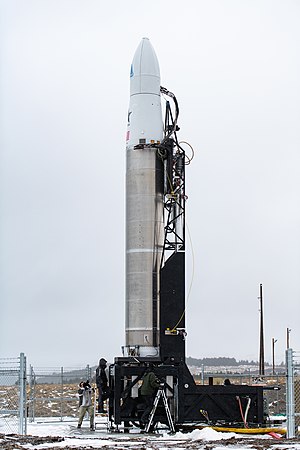This article needs additional citations for verification. (August 2023) |
 Rocket 3.0 being prepared to launch. | |
| Function | Orbital launch vehicle |
|---|---|
| Manufacturer | Astra |
| Country of origin | United States |
| Cost per launch | US$2.5 million[1][2] |
| Size | |
| Height | 43 ft (13 m)[3] |
| Capacity | |
| Payload to SSO | |
| Altitude | 500 km (310 mi) |
| Mass | 20–50 kg (44–110 lb)[4] |
| Associated rockets | |
| Comparable | |
| Launch history | |
| Status | Retired |
| Launch sites | PSCA, CCSFS SLC-46 |
| Total launches | 7 (+1 rocket destroyed before launch) |
| Success(es) | 2 |
| Failure(s) | 5 (+1 rocket destroyed before launch) |
| First stage | |
| Powered by | 5 Delphin |
| Maximum thrust | c. 32,500 lbf (145 kN)[3] |
| Propellant | Kerosene/LOX |
| Second stage | |
| Engines | 1 Aether |
| Thrust | 740 lbf (3,300 N) vacuum[3] |
| Propellant | Kerosene/LOX |
| Function | Orbital launch vehicle |
|---|---|
| Manufacturer | Astra |
| Country of origin | United States |
| Size | |
| Height | 18.9 m (62 ft) |
| Capacity | |
| Payload to LEO | 550 kg |
| Launch history | |
| Total launches | 0 |
| First stage | |
| Powered by | 2 Chiron (Firefly Reaver engine variant) |
| Maximum thrust | c. 70,000 lbf (310 kN) |
| Propellant | Kerosene/LOX |
| Second stage | |
| Engines | 1 Hadley ITV |
| Thrust | 6,500 lbf (29,000 N) vacuum |
| Propellant | Kerosene/LOX |
The Astra Rocket was a small-lift space launch vehicle series designed, manufactured, and operated by American company Astra (formerly known as Ventions). The rockets were designed to be manufactured at minimal cost, employing very simple materials and techniques. They were also designed to be launched by a very small team, and be transported from the factory to the launch pad in standard shipping containers.
The Rocket name was shared by several launch vehicles. Rocket 1 was test vehicle made up of a booster equipped with five Delphin electric-pump-fed rocket engines, and a mass simulator meant to occupy the place of a second stage. Rocket 2 was a prototype similar to Rocket 1. Rocket 3 was a launch vehicle which added a pressure-fed second stage to the Delphin-powered booster. Its definitive variant, Rocket 3.3, featured a lengthened booster, and delivered satellites to orbit. Rocket 4 was to have been an all-new design for a larger, more powerful rocket. The rocket family originated in Small Air Launch Vehicle to Orbit (SALVO), a small launch vehicle powered by Astra's electric-pump-fed liquid rocket engine produced for the DARPA ALASA program.[5] Following the end of the ALASA program, development of launch vehicle technology and systems continued, producing the Rocket family.[6]
The Rocket series was designed as a simple, low-cost space launch vehicle. No engine on the rocket made use of turbomachinery and the rocket's construction was of welded sheet aluminium as opposed to lightweight machined panels. It was also physically small, with the longest variant, Rocket 3.3, 43 ft (13 m)[3] in height.
Astra's Rocket series was developed with experience gained from the company's work on the SALVO air-launched launch vehicle, for which the Delphin rocket engine was designed. Its career was marked by several series of failures; of 10 launch campaigns, only 2 missions were successfully completed.
After the failure of Rocket 3.3 LV0010, production and operation of the Rocket 3 launcher was cancelled in favour of a new rocket, Rocket 4.
- ^ Sheetz, Michael (16 June 2020). "Rocket startup Astra trying for an orbital launch again in July, renewing fundraising efforts". CNBC. Retrieved 17 December 2020.
- ^ Heater, Brian (3 February 2020). "Rocket startup Astra emerges from stealth, aims to launch for as little as $1M per flight". TechCrunch. Retrieved 17 December 2020.
- ^ a b c d "Astra Media Kit LV0006" (PDF). 28 August 2021.
- ^ "NASA LSP Fact Sheet for Venture Class" (PDF). May 2021.
- ^ Foust, Jeff (2 June 2014). "DARPA Developing Operational Pathfinder for ALASA Air Launch System". SpaceNews. Retrieved 26 September 2023.
- ^ "Development and Flight-Testing of a High-Performance Electric-Pump Fed Launch Vehicle". NASA TechPort. NASA. Retrieved 11 June 2024.